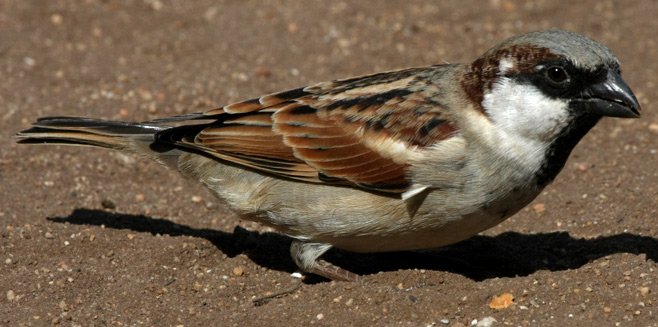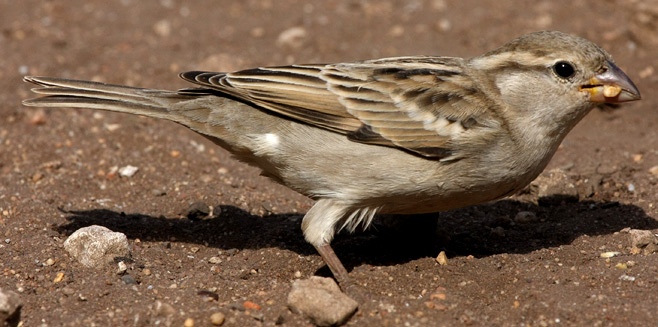|
Passer domesticus (House sparrow)
Huismossie [Afrikaans]; Enzunge (applied to some of the
bishops, widows and sparrows) [Kwangali]; Serobele (generic term for sparrows)
[South Sotho]; Jolwane [Swazi]; Tswere (generic term for sparrows, petronias and
canaries [Tswana]; huismus [Dutch]; Moineau domestique [French]; Haussperling
[German]; Pardal-dos-telhados [Portuguese]
Life
> Eukaryotes >
Opisthokonta
> Metazoa (animals) >
Bilateria >
Deuterostomia > Chordata >
Craniata > Vertebrata (vertebrates) > Gnathostomata (jawed
vertebrates) > Teleostomi (teleost fish) > Osteichthyes (bony fish) > Class:
Sarcopterygii (lobe-finned
fish) > Stegocephalia (terrestrial
vertebrates) > Tetrapoda
(four-legged vertebrates) > Reptiliomorpha > Amniota >
Reptilia (reptiles) >
Romeriida > Diapsida > Archosauromorpha > Archosauria >
Dinosauria
(dinosaurs) > Saurischia > Theropoda (bipedal predatory dinosaurs) >
Coelurosauria > Maniraptora > Aves
(birds) >
Order: Passeriformes > Family: Passeridae
 |
|
|
House Sparrow male, De Hoop Nature Reserve, Western Cape,
South Africa. [photo
Duncan Robertson ©] |
|
 |
|
| House Sparrow female, De Hoop Nature Reserve,
Western Cape, South Africa. [photo Duncan Robertson
©] |
|
Distribution and habitat
Although it originated from Eurasia it was introduced to
Australasia, the Americas and Africa, specifically along the Nile River and
separately from southern DRC through Zambia and Angola to southern Africa. Here
it is locally common across South Africa (where it was originally introduced),
extending into Zimbabwe and Botswana, while more scarce in Namibia and
Mozambique. It generally prefers urban, rural and suburban areas, sometimes
occurring around remote abandoned buildings in other habitats, such as semi-arid
shrubland.
|
 |
|
Distribution of House sparrow in southern Africa,
based on statistical smoothing of the records from first SA Bird Atlas
Project (©
Animal Demography unit, University of
Cape Town; smoothing by Birgit Erni and Francesca Little). Colours range
from dark blue (most common) through to yellow (least common).
See here for the latest distribution
from the SABAP2. |
Predators and parasites
It has been recorded as prey of the following animals:
Food
It eats a variety of different food, including seeds,
nectar, fruit and invertebrates, using a wide range of foraging techniques. It
most commonly plucks food items from the ground, but it may glean insects from
foliage or hawk small prey aerially. The following food items have been recorded
in its diet:
- Plants
- seeds
- nectar of Aloe marlothii (Mountain aloe)
- flowers of Sideroxylon inerme (White milkwood)
- Invertebrates
Breeding
- It is monogamous with a life-long pair bond, usually nesting solitarily in
southern Africa, even though it is colonial in Europe.
- The nest is built by both sexes, consisting of a ball-shaped structure
with an entrance on the side or on the top, usually made of grass, feathers,
wool and other soft material. It is typically placed in a building, such as
in a hole, under eaves or in a thatched roof, but it may also use an old
palm tree or the nest of a swallow, especially the following species:
- Egg-laying season is year-round, peaking from September-December.
- It lays 1-6 eggs, which are mainly incubated by the female for about
11-14 days.
- The chicks are brooded and fed by both parents, leaving the nest after
about 14-22 days and becoming fully independent about two weeks later.
Threats
Despite its abundance it seems to have a minor impact on
indigenous birds of southern Africa, although it may have displaced
Cape wagtails from urban
areas, as they both adept at scavenging in these environments.
References
-
Hockey PAR, Dean WRJ and Ryan PG 2005. Roberts
- Birds of southern Africa, VIIth ed. The Trustees of the John Voelcker
Bird Book Fund, Cape Town.
|
